Best Italy’s underrated archeological sites
With a rich history that spans millennia, Italy is naturally home to hundreds of interesting archeological sites. Once you’ve admired the majesty of the Colosseum and walked through the preserved streets of the city of Pompeii, there are still plenty of noteworthy archeological areas throughout Italy to explore. The following list contains our favorite outdoor archeological sites that history and architecture lovers shouldn’t miss.
1. Aosta’s Roman Ruins
Known as the “Rome of the Alps,” the city of Aosta is home to an impressive number of Roman ruins. Tucked away in the small region of the Aosta Valley along the border with France, a stroll through Aosta’s city center offers views of one remarkably well-preserved Roman monument after another, effectively making the city a large outdoor archeological site. Our knowledgeable and local guides who have extensively studied the city’s past and played among the Roman ruins as kids would love to show you around this ancient city.
Among the most evident vestiges of Aosta’s Roman founders are the imposing city walls, which continue to welcome visitors as they enter into the city. Amazingly, the thick concrete and stone walls are nearly fully preserved. Reaching a height of 21 feet, it’s possible to walk along the walls and admire the original Roman gates, two of which remain intact, as well as towers built during the medieval period.
As you begin exploring Aosta, take note of the streets. The orderly arrangement follows a Roman plan and your guide will explain how the city’s layout served the Romans from a strategic standpoint. Within the city walls are the ruins of the Roman Theater, which nowadays hosts concerts in the summer and the city’s annual Christmas market in the winter. Near the theater, remains of a later Roman amphitheater and marketplace have been uncovered.
With Augusta Praetoria Salassorum as the city’s original Roman name, it’s no surprise that a magnificent triumphal arch dedicated to Emperor Augustus stands just outside of the city walls. As one of Aosta’s most important monuments, the arch commemorates the Roman defeat of the Salassi tribe and the founding of Aosta. There are also two Roman bridges of note, one near the arch, called Ponte di Pietra, which once crossed the Buthier River, and the Pont d’Aël, which served as an aqueduct and transported water to the Roman colony. Today it’s possible to walk along the top of the latter bridge and admire views of the surrounding area.
With the exception of Rome, there’s truly no better place than Aosta to fully appreciate the vast history of the Roman Empire while experiencing countless ancient remains up-close.
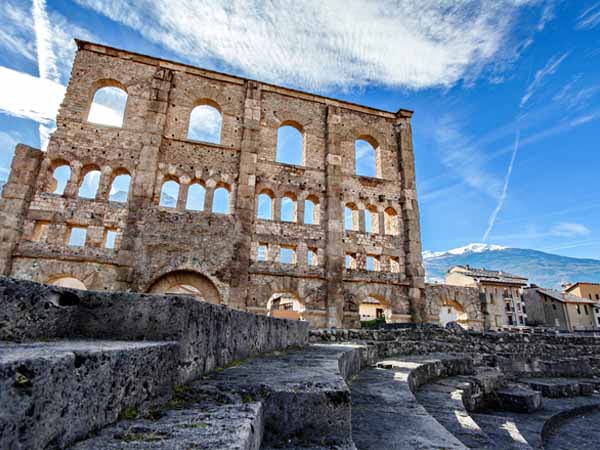
2. Aquileia
Taking into account its current modest appearance as a small town in the Friuli Venezia Giulia region, it can be hard to believe that Aquileia was once among the largest and most important cities in the ancient world. After its founding in 181 BC, Aquileia served as a trading center and military outpost for the Romans until it was destroyed by Attila in the fifth century. Subsequently, Aquileia became an important hub for the spread of Christianity throughout Europe.
Declared a UNESCO World Heritage Site in 1998, Aquileia differs from other archeological sites in Italy as it remains largely unexcavated. Visible ruins are scarce and primarily include a bath complex, residential structures, funerary monuments, part of the amphitheater, and several columns of the Roman Forum — which have become a symbol of Aquileia.
In addition to these remnants, a treasure trove of Roman artifacts lies just beneath the vast green fields. As a result, Aquileia is one of the most important archeological reserves in the world. The ruins of the ancient city even extend to the port area. Aquileia’s strategic position on the Natiso River helped it become one of the wealthiest cities in the Roman Empire and various port structures can still be observed today.
Covering nearly 400 acres, the expansive archeological site is best explored with an expert guide. Our skilled guides provide historic context and ensure you don’t miss anything, which is especially important in Aquileia since most of the structures are still underground. To supplement your visit, stop by the National Archeological Museum where more than 2,000 ancient artifacts are on display.
Last, but certainly not least, travelers shouldn’t miss Aquileia’s Patriarchal Basilica, a medieval church built on top of an ancient complex. The current church houses a stunning fourth century mosaic floor, which is the single largest mosaic work in Italy.
Sitting at the crossroads of Ancient Roman and Early Christian history, modern Aquileia is a small town with an immense past.
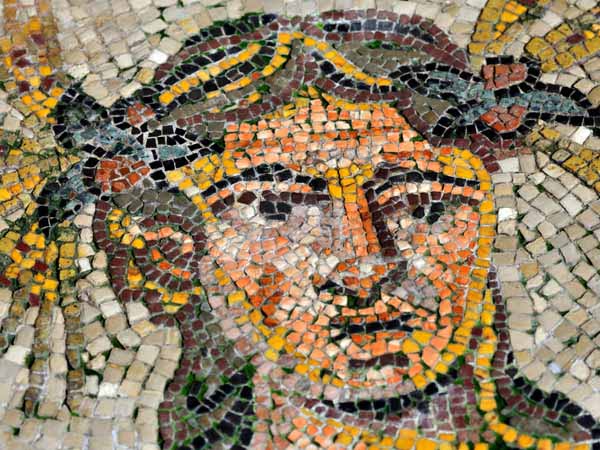
3. Rock Drawing in Val Camonica
Italy’s first UNESCO World Heritage Site is tucked away amongst the Alpine valleys of eastern Lombardy in the province of Brescia. Known as Val Camonica, this area is home to over 140,000 figures and symbols carved into the local rock. Created over a period of more than 8,000 years, the drawings in Val Camonica are considered to be one of the largest collections of prehistoric petroglyphs in the world.
Because the carvings are spread across a large valley and encompass 8 local parks, touring the area with a local guide is a must. Trips 2 Italy guides, who have studied the drawings and local history for years, are eager to share their insight with you.
The petroglyphs themselves are diverse and depict a variety of important cultural aspects, such as hunting, in addition to symbols and geometric figures. Interestingly, the drawings also mark cultural shifts in the local population, such as the transition from a hunter-gatherer lifestyle to farming. The interpretations of the drawings provided by your guide will be essential to understanding prehistoric customs and mindsets.
Discovered at the beginning of the twentieth century and declared a UNESCO World Heritage Site in 1979, the rock drawings provide a valuable look at the history of mankind from the Neolithic Period to the Middle Ages. Visitors will be amazed by the level of detail achieved by our ancestors with primitive tools.
For a truly unique outdoor museum surrounded by pristine natural beauty that will satisfy both historians and hikers, look no further than Val Camonica.
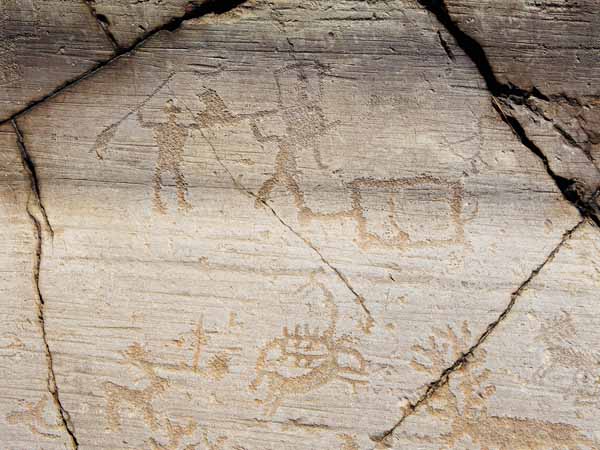
4. Paestum
Often overshadowed by its neighbor to the north, Pompeii, the ancient city of Paestum is more than worth a visit in its own right. Founded by the Greeks as Poseidonia in the seventh century BC then conquered by the Romans, Paestum was eventually abandoned in the Middle Ages before being rediscovered during the eighteenth century. As a result, much of the original Greek city is intact, including three ancient temples.
While the ancient city once covered nearly 300 acres, nowadays approximately 62 acres have been excavated and can be visited. Spend a day exploring this incomparable archeological site with a local guide who will help you travel back in time to Magna Graecia.
Follow your guide through the ancient roads paved by the Greeks to experience Paestum through the eyes of a local. Along the way, you’ll have the chance to admire the nearly complete city walls, which span 3 miles, the amphitheater, and, of course, the temples that were constructed over a period from approximately 550 BC to 450 BC.
In addition to the Greek temples, it’s also possible to take in remains of the city’s Roman period including the forum, amphitheater, and a temple. Also of note are the painted tombs that date back to the Greek and Lucanian periods. The most renowned is the Tomb of the Diver, which is on display at the Paestum National Archeological Museum among other ancient works of art including painted pottery and terracotta statues.
With its immaculately preserved temples, Paestum is perhaps the best place in Italy to trace the history and culture of the Ancient Greeks who settled in the southern part of the peninsula.
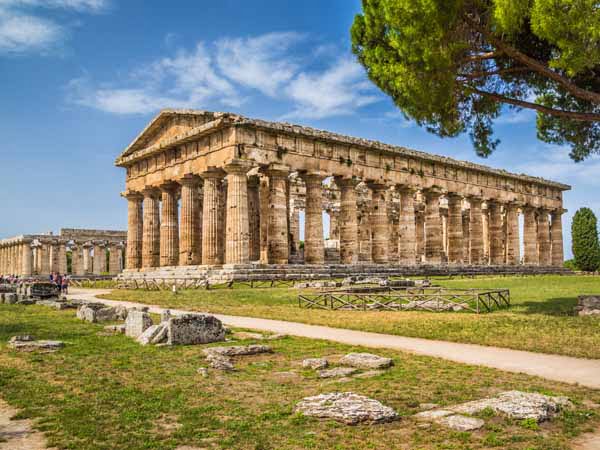
5. Sicily
As far as archeological sites go, the island of Sicily has it all — the remains of ancient temples, theaters, villas, mosaics, and much more. While the majority of Sicily’s archeological sites are of Greek origin, one exceptional Roman monument can be found near the town of Piazza Armerina.
The Villa Romana del Casale, a UNESCO World Heritage Site since 1997, boasts one of the most extensive and highly regarded collections of Roman mosaics on the planet. Dating back to the fourth century, the intricately detailed and elaborate mosaics span more than 37,000 square feet. The mosaics are in an impeccable state of conservation and offer invaluable insight into Ancient Roman culture. Due to its scale and variety of mosaics, Villa Romana del Casale is one place that would be simply overwhelming to visit without the guidance of a local art and history expert.
As for Greek ruins, one must-see is the Valley of the Temples. Also a UNESCO World Heritage Site, Agrigento’s Valley of the Temples is a vast archeological area home to some of the most well-preserved Greek temples in the world. With 11 magnificent temples and other ancient structures to explore, our local guides can’t wait to share their passion for this remarkable place with you.
Other noteworthy sites include the well-preserved Greek temple located just outside of Segesta, as well as the Greek amphitheater of Taormina, which today is one of Italy’s most evocative concert venues. Also not to be missed is Syracuse’s Neapolis Archeological Park, which features a Greek theater, a Roman amphitheater, and the Ear of Dionysus, a natural cavern with exceptional acoustics.
We’ve only scratched the surface of Sicily’s impressive array of archeological sites. In fact, the island is filled with gems that are best explored by car. If you choose to rent a car, your Trips 2 Italy travel package will include our personal off-the-beaten-path suggestions, while if you travel with a private driver, your driver will be more than happy to show you places only locals know about.
With so many archeological wonders to admire, a trip to Sicily offers unforgettable encounters with the island’s past.
From Roman ruins to Greek temples and prehistoric artwork, Italy’s outdoor archeological sites transport travelers back in time. Whether you’re a devoted history buff or simply take travel as an opportunity to learn about the world’s greatest ancient civilizations, there’s nothing quite like setting your eyes on a historic monument or work of art that has endured for thousands of years.
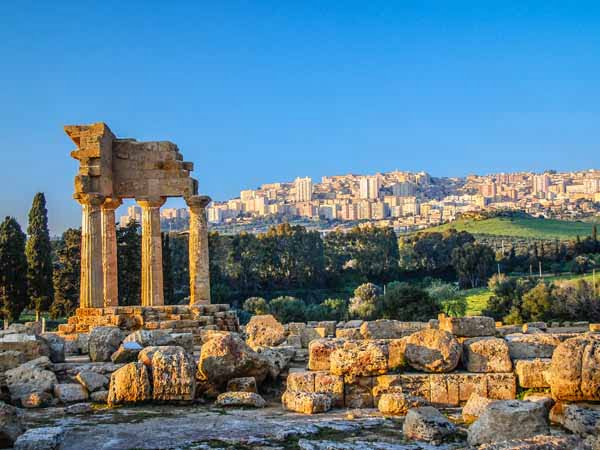
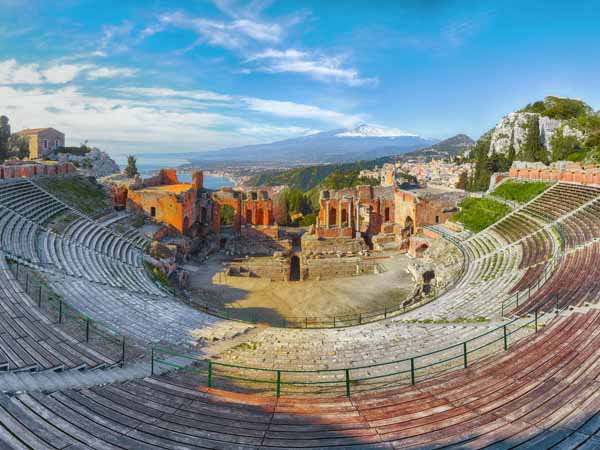
Of course, getting lost in some of Italy’s serious history doesn’t mean that you can’t enjoy other legendary sites or leisurely activities all during the same trip. From guided city tours and skip-the-line museum entrances to winery visits and tastings or even hands-on cooking classes, Trips 2 Italy can design the ideal itinerary so you can fully immerse in the country’s rich culture and traditions. If you are interested in any of these historic sites but can’t decide which area of Italy to visit first, contact your Trips 2 Italy travel specialist to customize your perfect travel package.